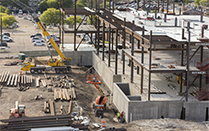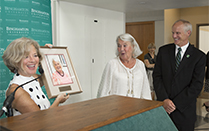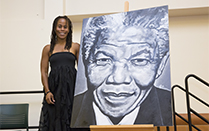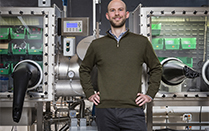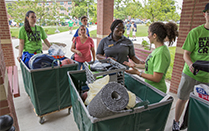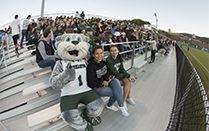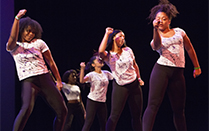Binghamton University President Harvey Stenger's Road Map Quarterly Report - September 30, 2016
The end of September arrives with clear skies and turning leaves on our campus. This is one of my favorite seasons here at Binghamton. Our freshmen have settled into life as college students and everyone is noticeably busier as we enter the heart of the semester. Visitors tell me how impressive the campus looks in the bright autumn sunlight, and my morning runs go a little quicker in the cooler air. This is just the way a premier public university should look and feel.
The return of thousands of students makes for a livelier campus in the fall, but that doesn’t mean that the previous three months have been uneventful. The past three months have been exceptionally busy preparing for and beginning the start of the new academic year; developing new programs and initiatives to support academic success, faculty research and scholarship; and working with our partners and stakeholders to strengthen our communities and build our impact and reputation.
Welcoming the Class of 2020
The new academic calendar started earlier than usual this year, when 2,620 freshmen students arrived Sunday, Aug. 21. This marked the first time Move-in Day has been held on a weekend, a change that makes it significantly easier for parents who work to bring their children to campus. It also dramatically reduced many of the parking and traffic challenges that have accompanied Move-in Day in the past, as many faculty and staff are not on campus on the weekend. As a result, the process of getting students into their residence halls was very smooth, despite the steady rain that fell throughout the day. Returning students arrived on campus the next day, and classes began on Thursday, Aug. 25.
This is clearly one of the best student cohorts Binghamton University has seen, with an average SAT score of over 1300. Given that they were selected from a record 32,000 applicants, we can proudly say that they are among the best students at any public university in the nation. Our entering class also includes almost 1,060 transfer students – many from local community colleges – though the class of 2020 represents a broad geographic diversity. Thirty-two percent of new students are from upstate New York; 7 percent are from Broome and Tioga counties; 26 percent are from Long Island; and 21 percent are from New York City. We also have about 700 new international students from 45 nations.
Importantly, we also welcomed around 1,200 new graduate students, bringing our unofficial graduate total to around 3,670 — up by almost 30 percent over five years. All told, with approximately 13,600 undergraduate students, over 17,200 students are enrolled for the fall 2016 semester, making this the largest student body in Binghamton’s history. And, for the first time, we highlighted our inclusiveness with a special Multicultural Extravaganza at the Anderson Center to unify and educate our students about the value of diversity. The event included performances by a number of our cultural organizations and a keynote by noted author, filmmaker and associate professor at Morgan State University, MK Asante.
The work of making this a welcoming and inclusive campus can be difficult, and this was made clear when controversy developed over a training session for new residence assistants (RAs). Organized by several current RAs, the optional session used an unfortunate title that was meant to be ironic, but, when taken out of context could be construed as offensive and threatening. That was certainly not the intent of the training session, though reports in the press and in social media initially failed to make that distinction. Behind the controversy over the program name was an honest effort to lead a productive discussion about race and diversity, which in fact occurred. We have learned from the experience and in the future the University will be reviewing training session titles and content to ensure that we clearly indicate that the University is a welcoming and inclusive place.
For the third year in a row, our entering students have had the opportunity to participate in a Welcome Week Service Project, providing helping hands to several local nonprofit organizations. Participants learn about the operation, history and impact of each organization and work with a small group of peers during a day of community service and fun social activities. Some of their projects included painting a mural in downtown Binghamton, preparing classrooms at the Family Enrichment Network and helping seniors in Johnson City use technologies such as cell phones and computers. This program gives students an introduction to the University’s emphasis on service learning and welcomes them into the community in which we live and work.
It’s clear that our students have a positive impact on the community, not only in their service and engagement with local organizations, but also through the economic activity they generate. Last year Binghamton University students spent over $150 million, with an estimated economic impact of $237 million on the local economy, and helped support 2,560 jobs in the local area, according to the University’s economic impact report.
Even as we were preparing for and welcoming our new students, we also had a very busy summer recruiting future classes. All told, more than 12,000 prospective students and their parents toured Binghamton from May to August. That number is 1,000 more guests than visited in summer 2014. This brings the total number of visitors last year to almost 43,000 – a sure sign that Binghamton is getting recognized. The busiest stretch was the week before Labor Day, when nearly 3,000 visitors toured our campus, just as we were welcoming our current students back. And judging from the large number of younger brothers and sisters these visitors had in tow, we are already making headway in recruiting students for future classes in the coming decade.
Campus visits have become a staple for students and families who want to find the college that is the “perfect fit.” As Binghamton’s national and international reputation grows, many prospective students from other countries find it difficult or impossible to travel to Binghamton to see our campus firsthand, and instead rely on advisors and guidance counselors to recommend the best American colleges. So we were pleased to host a group of international visitors here as part of Education USA – a U.S. Department of State initiative with branches in about 150 nations, that provides guidance to students in those countries who are looking to study in the U.S. The visitors themselves came from 11 different countries, and their stop at Binghamton gave us an opportunity to highlight our commitment to internationalization and diversity, as well as our outstanding academics. As a result of this visit, I think we can expect to see Binghamton’s global profile raised in terms of what we do and that will, in turn, bring more interest from international students and scholars.
Closer to home, our campus is also drawing interest from New York’s community college students. In an effort to strengthen and formalize the ties we have with these institutions, we entered into an agreement establishing the Binghamton Express program with SUNY Corning Community College. This program is similar to the Binghamton Advantage Program that we established with SUNY Broome several years ago, in that it provides for automatic acceptance for community college students who meet Binghamton’s academic requirements. The Binghamton Express program strengthens our collaboration with our community colleges and widens the pipeline for New York students seeking higher education. Most importantly, it will help keep the best New York students in the region so that they can fill jobs as they become available in the years following graduation. These are students who want to stay in New York and who want to contribute to the region’s success.
New faculty and support for teaching
Also joining our campus this fall are more than 50 new faculty members and a comparable number of new staff. We are currently nearing the end of the faculty hiring initiative that began in 2012, that has enabled us to increase the number of net tenure-track faculty by 136. This increase in faculty is helping us turn the corner in reducing our student-to-tenure-track faculty ratio. At the same time, we’ve increased support staff by about 15 percent, helping to ensure that students are able to receive the services they need to succeed at Binghamton and that faculty have the support they require to excel in their fields.
The achievements of our faculty are regularly recognized at state, national and international levels, and because we think even the best professors can use assistance to become better teachers, Professor James Pitarresi has added the title of vice provost and director of the Center for Learning and Teaching (CLT). Pitarresi had previously been focused solely on the work of the CLT, but Provost Donald Nieman and I recognized that this role was a little too narrow for someone with his vision regarding enhancing the teaching process on campus. As vice provost he will work to help improve retention and graduation rates, as well as oversee Commencement, new faculty orientation, the Binghamton and McNair Scholars programs, as well as our collegiate professorships. We are looking forward to seeing his contributions in his expanded role.
The CLT is rapidly becoming the go-to place for faculty interested in improving their pedagogy. We are fortunate that many of our alumni and supporters share this goal and are working to help the campus develop new approaches to teaching and learning. In September, we took time to recognize the support that Mark Zurack ’78 has provided the CLT in finding ways to use technology to create a more collaborative, team-centered and student-centered learning process. A new room in the CLT has been named the Zurack Family High-Technology Collaboration Center, a learning studio equipped with glass white boards and Cisco “telepresence” technology that allows students to connect with faculty and alumni for state-of-the-art teaching and collaborative learning. This is only the latest of a long string of transformative donations provided by the Zurack family, and the University is grateful for their support.
Homecoming and Family Weekend
The dedication of the Zurack Family Center took place during this year’s Homecoming celebration, which, by all accounts was very successful, with a record 1,400 alumni returning to campus to reminisce, network and learn about changes taking place at their alma mater. It was an event-filled weekend with a range of activities for students and alumni, including a celebration of campus radio station WHRW’s 50th anniversary, alumni-taught seminars on current events, a student-run fashion and the traditional tailgate followed by a men’s soccer game that saw Binghamton win decisively over SUNY rival, the University at Buffalo. But for me, the highlight was a performance by the world-renowned Bill T. Jones/Arnie Zane Company, where I presented the former Binghamton University attendee the University Medal in recognition of his work and his role in raising the University’s profile.
Homecoming was preceded by our annual Family Weekend which drew more than 5,000 parents and siblings to campus. This number includes more than 200 parents who themselves attended Binghamton University. These “legacy” families are very important to the University as they are a clear demonstration of both the impact that the University has on our alumni and the sense of community that we try to develop here. Given our successes in the last few years, I am confident that the number of legacy families will continue to grow. The University organized a number of informational sessions for parents to tell them more about our academic programs and student services, so they can be more engaged and effective in supporting their students’ success at Binghamton. And of course there were many opportunities for family fun as well, including movies and games, bonfires, tours of the Nature Preserve, concerts and comedians.
State of the University and the Road Map
One of the rituals of the academic year is the State of the University address that I give to students, faculty, staff and community members. This year, I outlined some of our recent successes and identified the chief challenges that lie ahead — as well as the strategies we will use to meet them. The four years since the implementation of our Road Map have been marked by real advances for the campus – ranging from the Road Map itself to the introduction of Transdisciplinary Areas of Excellence (TAEs), the establishment of our new School of Pharmacy and Pharmaceutical Sciences, and progress on the new Southern Tier Health Sciences and Technology Innovation Park in Johnson City as part of the state’s Upstate Revitalization Initiative (URI). Among the challenges the campus faces are changes in state funding as a result of the non-renewal of NYSUNY 2020 by the state legislature as well as the prospect of a new SUNY chancellor next year. I believe that the best way for the University to address these challenges is to better harness the collaborative spirit that animates so much of what we do here.
In my presentation, I highlighted three different projects that exemplify the range of collaborative interactions that drive University initiatives – the new Innovation and Design Center that highlights partnerships between departments and divisions; the Living Building at Nuthatch Hollow that is being developed through collaboration between divisions, TAEs and local stakeholders; and the NextFlex Manufacturing Innovation Institute at the Center for Advanced Microelectronics Manufacturing (CAMM) in Endicott that is thriving due to growing ties between the University and external agencies and institutions. Noting that it has been five years since the campus came together to develop our strategic plan, I closed my remarks by announcing that the University will launch a Road Map Renewal to develop ideas that emphasize collaboration and teamwork in order to meet the challenges of the coming decade. Individuals who would like to participate in the Renewal can submit their names and ideas online. The renewal timeline will be short. Teams will launch in December, work through the spring and prepare final reports in April.
Meanwhile, the Road Map Steering Committee, with input from the Faculty Senate Budget Review Committee, has ranked and prioritized 10 proposals that merit funding as part of the Road Map 2017-18 allocations. In addition, we’ve identified 17 more proposals that will receive some level of funding from divisional operations budgets. Overall, we received a total of 76 proposals, so more than one-third of these will receive some support.
Proposals that will be funded by $2 million in Road Map funds include:
• an increase in internet capacity for the campus,
• a feasibility study for our next comprehensive gifts campaign,
• Science 5 research infrastructure enhancements,
• upgrades for our student Public Speaking Lab
• and development of a Smart Laboratory for our Freshman Research Immersion program
We are in the last year of our current Road Map budget formula, so most of the money available has been allocated on a one-time basis, with less money overall to support promising proposals. As a result, the University’s divisions have opted to fund a number of important initiatives out of their existing operations budgets. Among the proposals that will be funded from the divisions are:
• support for instrumentation for the Health Sciences Core Facility,
• an upgrade of the sound system in Watters Theater,
• a technology security operations center for our IT operations,
• renovation of space for our Employee Assistance Program,
• and resources to help the campus coordinate University-led initiatives as part of the URI and Southern Tier Regional Economic Development Council.
In addition, at a recent meeting of the Binghamton University Foundation Board of Directors, the Foundation agreed to provide some support for key University projects through its Strategic Initiatives Fund. Projects that will receive support include:
• funding for advertising to help build our reputation and reach,
• support for a Geographic Information Systems Core Facility,
• support for high-impact and experiential education programs,
• resources to enhance faculty diversity
• and seed funding for planning and execution of our next comprehensive gifts campaign.
When the Road Map was first launched, I decided that it would be good to involve some of our best students in the strategic planning process by inviting some of our Binghamton Scholars to participate in a two-credit internship program that involves research, class discussions and guest speakers. This has become one of the favorite aspects of my job – I get to teach teams of students about planning. In this program, student teams identify strategic needs for the campus and develop proposals to address them. This year’s proposals include:
• recommendations for changes in the services provided in the University Union, such as bringing in local businesses to provide services such as a pharmacy, café or movie theater,
• working to improve the first-year experience by enhancing our Welcome Week,
• revamping Homecoming to increase alumni-student interactions,
• enhancing off-campus safety,
• establishing a new and revamped Welcome Center for prospective students and parents
• and working to strengthen student-faculty connections.
I am very excited about the progress and success of these projects as they are being developed by students who are both engaged with the University and understand the needs and interests of their peers.
Southern Tier Regional Economic Development Council
The Southern Tier REDC (STREDC) held meetings in September to identify proposals that will be forwarded to Albany as part of the fifth round of REDC funding. All told, around 170 different projects were submitted, which were then scored and ranked by the executive committee.
This year, the amount of money being awarded is significantly less than in previous years (awards will be $10 or $25 million per region), so identifying and ranking quality proposals has been much more difficult. It is important to note that the REDC has established procedures to ensure fairness and equity in the process, such as barring members of the executive committee from voting for projects in their immediate communities. Scoring criteria include the amount the proposal expects to leverage from private sources, the number of jobs retained and created, and the specific source of state funds to support the project. After meeting and discussing the merits of each project, the STEDC has agreed to move forward on 21 proposals that will generate over $175 million in local economic activity. These projects will be presented to Albany in November with the Gov. Andrew Cuomo’s office making a final decision in mid-December.
After several years of having a lead role in the REDC process, Binghamton University’s participation in these proposed projects is more limited, although several of the proposals will have an indirect impact on the University – for example, research partnerships with Corning Pharmaceutical Technologies and a proposal to relocate the Salvation Army Job Training Center that will free up property next to the University Downtown Center.
Meanwhile we are moving forward on existing REDC and URI projects. The Southern Tier High Technology Incubator, with the University playing a lead role, is on schedule to open next year, as is the Global Center. Early work on the Health Sciences and Technology Innovation Park is moving forward, and we are submitting an application for funding for 48 Corliss St. and several other projects as part of the URI. Support for the Freshman Research Immersion program, which provides immersive research experiences in the STEM fields, is also moving forward. In addition, the Greenway project that will link the University to downtown Binghamton is currently in the design phase.
So it’s been a very busy summer at Binghamton University. We’ve successfully welcomed a new class and introduced new faculty, staff and visitors to the campus. We’re strengthening our teaching and providing new resources for research, scholarship and creative activities. We’ve shared our successes with our alumni at Homecoming and encouraged parents to engage in their students’ education at Family Weekend. I’ve detailed the State of the University and invited everyone to help Renew the Road Map. And we continue to make progress on transformative initiatives as part of our state’s economic development programs.
Given these achievements and the legacy of academic excellence at Binghamton, it’s not surprising that we continue to be highly ranked by in the popular press. Earlier this month, U.S. News & World Report recently ranked us 86th on its Best National Universities list – up three spots from last year. And we were the highest ranking SUNY on the list.
Our International reputation is also growing, as Business Insider Singapore ranked Binghamton as the 10th best public college in the nation. And once again, Binghamton has made the cut as one of the top 26 healthiest campuses, according to the online publication Greatist.com.
These rankings are just one of the reasons it’s been a great start to the academic year, and I look forward to seeing what the rest of the year has in store.
Sincerely,

Harvey G. Stenger

